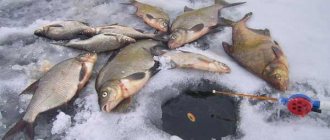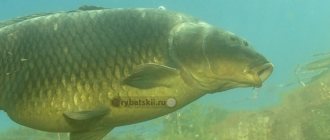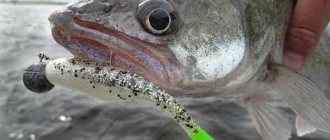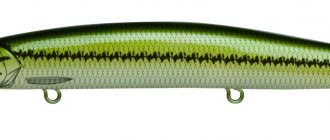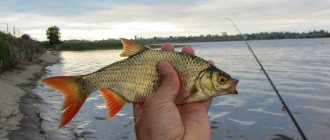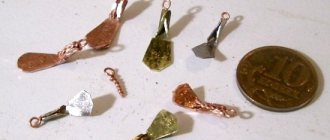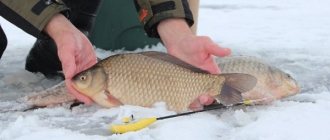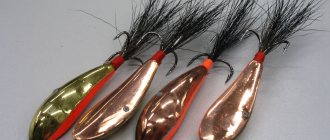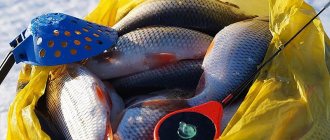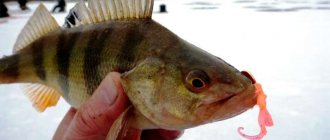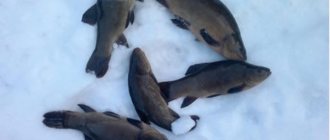Pike fishing depth
Everything is simple here. It is absurd to catch pike at a depth of a meter with a bait with a working depth exceeding the depth of the reservoir. Wobblers have different depth characteristics specified by the manufacturer.
Usually the indicated value coincides with the actual one and depends on the angle of attachment of the nose blade, the mounting loop, the shape and size of the blade. The speed of reaching a given depth also depends on these indicators.
Everything is more or less clear. If the blade is wide and attached to the body at a large angle, the closer to the surface of the water the movement will be. Which is optimal for catching pike in shallow waters, with a background depth of up to a meter.
The smaller the angle of inclination and the longer the blade, the deeper the bait dives. Additionally, you should pay attention to the location of the fastening loop. In deep models it is often located on the shoulder blade itself.
Tactics and fishing techniques
For a successful fishing outcome, it is not enough to choose suitable and reliable equipment. It is also necessary to develop tactics and choose a fishing technique. In order not to make a mistake in this, you first need to figure out the place, taking into account the lighting, wind direction and the presence of factors such as bushes and trees that may interfere with making a long cast. Of course, each fisherman will have his own selected fishing technique. But it’s best if it’s a classic, effective game with pauses and jerks. Their frequency depends on the selected popper.
To determine whether the wiring is correct, you need to look at what sounds the bait makes when jerking. They should be stable, eye-catching and gurgling. Small fountains of spray should also diverge to the sides.
The game shouldn't be stable, it should be interesting. It is best to experiment with wiring and change equipment periodically. This will attract the attention of even the most suspicious fish.
You can try to catch some representatives of predatory species using a simple uniform retrieve. This tactic is best used in reservoirs with decent depth and abundant vegetation. But you shouldn’t get carried away with such wiring, alternating it with a faster game.
Wobbler buoyancy
The most difficult stage of selection. It all depends on the real preference of the pike and the area in which you manage to catch it.
If we consider a specific fishing area, the determining factor is the clutter of the reservoir. If there is a high risk of losing the bait on the hook, I try to use floating models. If you saw an obstacle in polarized glasses, touched a snag or vegetation, let the wobbler float freely. Let him get up and go around the shitty place.
When the depth and “purity” of the reservoir allows pinocchio fishing without much hassle, I prefer a suspender. And the pike is extremely happy with this option. True, we still need to look for pure suspenders with absolute neutral buoyancy, but a little positive or negative buoyancy is often beneficial.
If the depth allows, then the sinking model becomes very effective against large pike. “Mothers” tend to stand lower than the majority of fish.
But it’s more difficult with the pike’s mood. There are quite a lot of factors influencing the bite and they change periodically. Before throwing a wobbler, you have to chase baits with different characteristics for some time.
I’ll note that usually my pike doesn’t particularly react to fast-rising baits. Only a very active beauty becomes a trophy. Suspenders with minimal positive buoyancy and slowly rising models, as a special caste, are most preferred in the eyes of pike.
Materials
- a suitable piece of soft hardwood (poplar is best);
- stainless flexible wire with a diameter of about 0.6-0.8 mm;
- lead strip 1-3 mm thick;
- Poxipol glue;
- acrylic putty for wood;
- white emulsion paint;
- aerosol paints;
- pearl/silver nail polish;
- waterproof marker;
- colorless waterproof varnish;
- bead made of brass or plastic;
- anchor;
- petal;
- feathers.
Read: How to make catchy spoons
What type of wiring should a wobbler have for pike?
Despite the fact that wobblers are produced with already specified behavior parameters in water, the main task is performed by the spinning rod. The angler was able to determine the makings of the bait and pick up the key to it - there will be pike and perch. If not, then excuse me, the result will be predictable.
This is why there are so many questions on the forums not only about which wobblers are the best for pike, but also about wiring. Frankly speaking, I would like to answer such questions, but there is not much point.
We are all different people, with our own temperaments. The gear is different, the fishing location, the lighting, the water temperature. Everything takes its toll. The described wiring of the type “two jerks - pause - three jerks - pause” does not mean anything. Every pikeper finds the golden mean experimentally.
Naturally, it is worth taking into account the temperament of a plastic fish. There are pinocchio with active play, and there are with passive play. What the pike likes - only it knows.
Rotating spinner
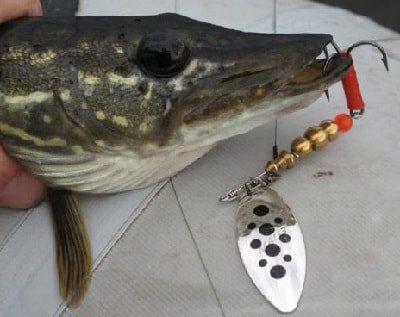
Turntables cost less than wobblers. According to the Mepps classification, pike sizes include spinners starting from the third number. The shape of the pinwheel petal is not particularly important. There are pinwheels with one, two and three petals. There is a special type of spinners, or rather their modifications - spinnerbaits, which combine spinners and jig baits.
The most popular petals for pike: Aglia, Aglia-long, Comet.

Choosing the size of a wobbler
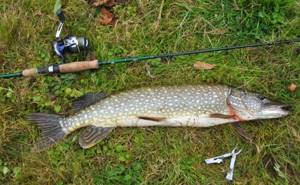
Everyone has heard that the mouth is happy with a large piece. Still, I recommend not to rely too much on this. There are too many facts when changing a bait from a size 120-130 to a size 50-90 leads an angler to results.
And seasonality is not to blame. Even in the spring, before spawning, I prefer to persuade pike to attack large-sized fish, and in the fall I do not hesitate to use small-caliber infantry. And the size of the prey is often surprising. Ultralight lovers will not let you lie.
Fishing with rattlins in winter
Ice fishing with weebs is different from regular trolling. Initially, you need to lower the ratlin closer to the bottom, and then slightly raise it by 20-50 cm. Then again slightly pull it by 10-30 cm, as a result of which the wobbler will begin to vibrate, spreading waves around itself. These water fluctuations are instantly caught by predatory fish, and it begins to approach the bait. After this, the vibration should be lowered slightly again, either evenly or stepwise. Then after 7-10 seconds you need to repeat the entire sequence of actions.
You should not make sudden upward pulls, so as not to scare away the prey. A bite most often occurs when the vibration freezes at the lowest point, or while it is lowering to the bottom. Therefore, it is recommended to hold the bait longer in these positions. At the same time, the technique of using ratlins on different fish differs from each other. Let's briefly look at how to catch this or that fish using a vibe.
Zander

In winter, pike perch is caught at great depths - up to 10 meters or more. Therefore, to fish it you need to choose fast-sinking heavy rattlins. The vertical wiring technique is as follows:
- Small shaking of the vibration at the very bottom.
- Throwing the bait up 20-50 cm, and smoothly lowering it back to the bottom.
- Then again a slow rise of the rattlin by 15-20 cm, and a gradual lowering with trembling at the bottom.
The recommended size of vibes for pike perch is 6-8 cm.
Pike
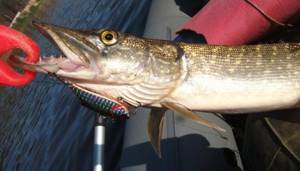
For pike, the largest ratlines are used - from 7 to 10 cm. This allows you to concentrate on a large trophy, eliminating bites from perches and other small things. The bait should be attached to the leash, otherwise there is a risk of it being cut off by the sharp pike teeth. There is no special technique when fishing for pike; a standard plumb line is used.
Perch
The smallest vibrations are used for perch, from 3 to 5 cm . This small aquatic predator loves active play with bait, with frequent upward twitches. It is also recommended to put multi-colored beads, fibers or feathers on the hooks. This will additionally attract his attention.
Trout
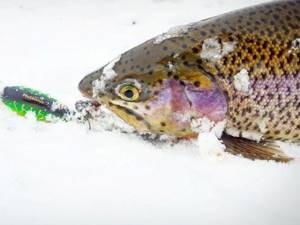
Some models of vib also perform well in winter trout fishing. It is clear that they are used most often on paid ponds, in vertical wiring, and not on mountain streams. Among the models that perform better when fishing for trout:
- Saurus Vivra;
- ZipBaits Calibra Fine-50;
- ZipBaits Rigge Vib-63.
In general, ratlins demonstrate their high efficiency when fishing from ice. In this regard, this type of bait is gaining increasing popularity among domestic ice fishing enthusiasts.
Lure color - for pike or angler?
Here my experiments continue. Despite the craze for “acid” products, I buy new items in bright colors just for myself. This makes it easier to notice the game and make the necessary changes. Even a natural fisher is quite capable of provoking a pike to attack.
I won’t argue on this topic, that aggressive colors are optimal for active pike, and it’s better to persuade passive ones with natural colors. He himself has reasons to say that in some reservoirs the predator prefers nondescript, minnow colors, while in others, give it a daring contrasting coloring, regardless of the fishing season and the mood of the fish. Only experiment brings experience and luck.
To summarize, I will again express my personal opinion that manufacturers have not yet released a wobbler for pike directly for sale. With a medium-sized wobbler you can quite easily catch pike, dace, and trout, and with the obviously “pike” Balisong 130 you can catch small perches.

The characteristics of the pinocchio matter, but the skill of the angler is fundamental. Therefore, for a beginner, look for information “What are the best wobblers for pike?” will be somewhat difficult.
And now directly about wobblers for pike fishing. In one of the magazines “Sports Fishing” No. 10 for 2014, master of spinning fishing Juris Tarvids published his article, where in a simple form he gives information about the classification of bait, its features depending on its shape. You can read it (the article) below. I am sure that any wobbler lover will find it useful.
Popular models and manufacturers
On the modern fishing equipment market there are a large number of rattlins from various manufacturers. It is difficult to determine exactly which company's products are the most catchy. This is due to many subjective factors - the skills of working with vibrations of each individual fisherman, the correct use of them, the time of year, etc.
The basic rule when choosing bladeless wobblers is to give preference to products from well-established manufacturers. Lures from unknown companies or outright fakes for the most part cannot well imitate the natural movement of a fish. As a result, their effectiveness is significantly lower than that of baits from leading companies.
Madness
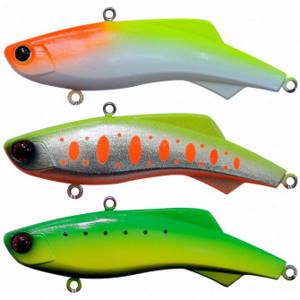
Currently, the market leaders are Japanese vibes, characterized by high quality workmanship and good play when retrieved. One of these companies that has proven itself well in the global market is Madness. Its product range includes wobblers specially designed for ice fishing, which are distinguished by their high catchability. This brand also produces vibrations for open water - fishing from the shore or from a boat.
Eclipse

Eclipse is another Japanese company specializing in the production of fishing tackle. The Eclipse vibes that make up the Slight series have earned particular popularity among ice fishing enthusiasts. All baits of this type are easy to use and do not require knowledge of special techniques. At the same time, they are quite effective when fishing from ice, showing good performance when fishing vertically.
Lucky John
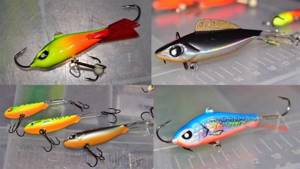
Lucky John is a Latvian company that entered the global fishing equipment market just a couple of decades ago. But today its products, numbering 4 thousand items, are widely known in Europe and Russia. Among the products produced by the Lucky John company, there are 3 models of vibes, each of which includes 2-3 sizes and a dozen color options. Latvian wobblers have earned popularity due to their good catchability and ease of trolling when casting vertically.
Ima
IMA is another company from the Land of the Rising Sun that produces fishing equipment. The most famous among the vibes of this company is the Koume series, which has a unique play with vertical wiring. The sizes of the bait range from 6 to 8 cm , and also differ in color options. The product range includes quickly sinking models and rattlins with neutral buoyancy.
Usami
The well-known Japanese company first introduced bladeless wobblers of its own production in 2010. At the same time, the company’s engineers did not waste time developing new vibrations, but took the path of improving existing models from other manufacturers. Since then, its products have received deservedly high praise among winter fishing enthusiasts. It is distinguished by its traditionally high quality and excellent winter luster properties.
Wobbler for pike: classification of bait
As you know, the main predator of our rivers and lakes is very indiscriminate in its diet. And you can seduce her with any artificial bait, you just need to choose a certain type of bait and use it in a certain place at a certain time. It just so happened that I had the opportunity to trace from my own experience the evolution of pike fishing with various spinning lures. My experience began in the 70s of the last century with oscillating and rotating spoons, since it was simply impossible to purchase other baits in the Soviet Union. And as my country entered capitalism, I had the opportunity to fish with soft spinning baits and, of course, wobblers. It is precisely about fishing for pike with a variety of wobblers that I want to talk about.
CRANK
Crank (crank can be translated as “roll”) was the first hard plastic bait with which I managed to seduce pike.
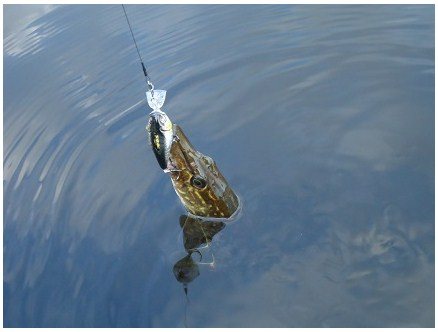
Apparently, this fact became the reason for my subsequent passion for pot-bellied wobblers. And then it turned into persistent loyalty, and even now, having a variety of baits, I use one or another crank on every fishing trip, and quite successfully, since the spotted beast does not ignore them. This is especially evident during periods of high “playfulness” of the predator - in the society of “search engines” for active pike, especially in vast reservoirs, crank wobblers occupy one of the leading positions.
The advantage of these baits is clearly evident when fishing in the spring, when the pike has spawned, or in the fall, when the predator is fattening up before the cold winter. It is at these times of the year that pike most favorably accept the offered cranks, especially those that “play” at shallow depths. In general, it can be said without exaggeration that cranks are one of the most popular baits for pike fishing until the water in reservoirs warms up thoroughly.
In the summer, priorities change, especially in sunny weather, when a predator on a hot day does not show any desire to chase too fast decoys. The only thing that can still work is deep-sea cranks that can go to depths of 1.5 m and below. It is precisely these wobblers that are capable of tempting summer pike to attack, especially during the period when the thermocline appears, when the fish concentrates at certain depths.
So, as we see, cranks are used at any time of the year. These lures are distinguished by their unpretentiousness in animation and good flight characteristics.
There is a slight deviation from the norm in this category: at the very beginning of the new millennium, models of pot-bellies consisting of two parts began to appear. For example, Aragon models, produced since 2004 under the Japanese brand Jackall.
At first, we were all happy, anticipating the increased interest of fish in compound fatties with a more active “game,” but soon our enthusiasm subsided a little, since such compounds clearly did not show any significant advantage over classic specimens. Maybe when fishing for bass (and this is what wobblers of this type are designed for), the difference between these crank options is more obvious, but not for our dear pike. In general, cranks, regardless of configuration, seduce an active pike without any problems, but it is very, very difficult to provoke a passive pike with them. But for this there are wobblers of other varieties. For example, minnows, which we’ll talk about later.
MINNOW
This type of spinning bait is most often found in the arsenals of our fishermen. Yes, and I have all kinds of minnow wobblers that significantly exceed the number of baits of other types, and the lion’s share of wobbler fishing time is spent fishing with them. Oh, it’s not for nothing that Lauri Rapala planed his first “piece of wood” in the shape of a minnow!
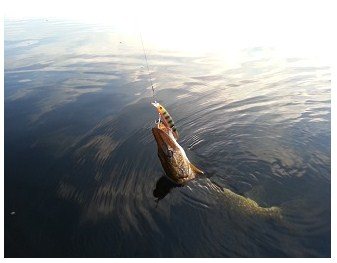
Why are they so good? Well, first of all, because they quite plausibly copy fry or small fish, the most accessible food item for pike. Apparently, this is precisely the main reason that convinces the pike to quickly attack various “mines”.
And the second reason is that when fishing with these baits we have the opportunity to use various types of animation. “Minoshkas” are animated with both uniform and uneven wiring, working only with a reel, as well as with the help of a rod, making all kinds of pulls or jerks.
Thus, we can select a key depending on the level of activity of the pike. This is precisely the main difference between minnow wobblers and crank wobblers. After all, when the predator is active and is looking for prey itself, you can seduce it with both a crank and a minnow, like any other bait. But to provoke her during her phlegmatic state and force her to attack is something only minnows can do, since they are best suited for jerking movements.
As for the size of minnow wobblers, pike can grab both short and long minnows with equal greed. There is an opinion among spinning anglers: if you want a big fish, put a big bait. But it is not always the case. Often, a large wobbler is attacked by a pike, the size of which is not much larger than the length of the bait itself. And, conversely, small minnows are often attacked by large pikes. But still, when purposefully catching a toothy trophy, it is recommended to use larger wobblers.
The only exceptions are minnows with a large blade. Let's try to figure out why? But because large fish usually stand deep, especially in summer, when the upper layers of the reservoir are thoroughly warmed by the rays of the sun. But even at other times of the year, when hunting large predators, the deepest horizons of any reservoir will be promising. Here the folk wisdom “Man looks for where it’s better, but fish looks for where it’s deeper!” That’s when deep-sea “minnies” become successful.
JOINTED
Wobblers whose body consists of several parts should be discussed separately. At this time, wobblers of almost all types are represented by articulated models. Even among poppers and walkers there are compounds. But this is, so to speak, exotic, an exception to the rule, so we will not consider such baits today. First, let's talk about models that are produced in large quantities and by almost all manufacturers - these are composite minnows.
My first branded bait of this variety was a representative of the Finnish Rapala, it was simply called Jointed. This wobbler, consistently bringing significant catches, greatly diversified my fishing - and since then, minnows have firmly taken their place in my working arsenal. And for more than ten years I have been trying to test in practice every model of compositors that appears on the market.
And there are many of them. These models often differ quite significantly from each other, each of them has its own “zest”. For example, the legendary Live Pointer model from Lucky Craft was first produced with a body of seven parts, and now with a body of thirteen.
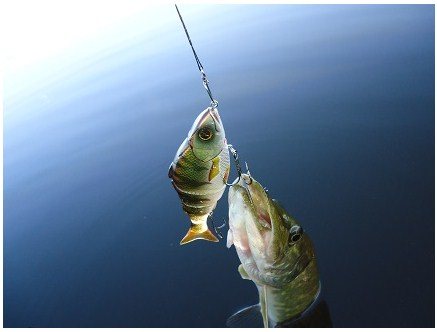
But, despite the external differences, we can confidently say that this category of wobblers belongs to baits with increased catchability. The lively “game” inherent in articulated wobblers is interesting not only to active fish. When using certain animation methods, the team is quite capable of attracting the attention of a sluggish pike, waking it up, forcing it to attack.
A striking example of such baits is Magallon, whose popularity has not declined for many years. This model has gained fame because it rarely goes without a catch. This is probably why Magallon is also available in a deep version, designed to tempt fish at depth. In general, a lot of deep minnows are being produced these days, and almost all of them deserve the closest attention, since they are in high demand among pike. But it should be taken into account that almost all of them are very capricious, requiring a special approach to animation. Many models have their own secret that the spinning angler needs to understand - and then the wobbler will be able to please its owner with stable catches.
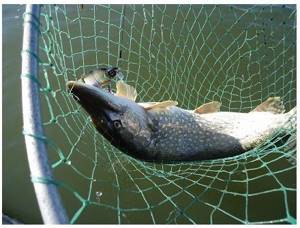
And this applies not only to composite models made in the form of a minnow. Many compounds are produced, the body of which very reliably resembles the outlines of the body of small crucian carp or roach. It was precisely these bladeless baits that became known as “Latvian baits” at the end of the last century. Many classify them as swimbait, but this is not entirely true, since many Latvian models have negative buoyancy. And here, in the homeland of these baits, they are usually called simply “components”. It’s short, clear and we understand what we’re talking about.
A modern representative of wobblers, consisting of several parts and very faithfully copying the body of a small fish, are representatives of the Shad Alive series, produced by Izumi. These baits require a special approach, since they accept various types of animation, allowing you to adapt to the specific state of the toothy predator.
Now, in addition to bladeless baits, the company also produces models with different blades, which enable the baits to “play” at different depths, up to four meters. Naturally, such an opportunity, which significantly expands the field of activity of the compilers, can only be welcomed. After all, as is well known, the more diverse our offers to the pike, the greater the chance that it will respond to one of them.
SHAD
The body height of shads significantly exceeds its thickness, which is a distinctive feature of baits of this type. My first shad lure was the famous Rapala model SSR-14 (Super Shad Rap). This wobbler brought quite good pike when fishing in a variety of reservoirs.

Due to the peculiar shape of the body, shads, in their inherent “game,” are like a transitional link between cranks and minnows. “Herrings” (as Shad is translated) are not as active as “pot-bellies”, but they also cannot boast such an impressive variety of types of animations as “minoshki”. And the agility similar to the above-mentioned categories of wobblers is clearly not observed in shads. But, thanks to their tall body, they are characterized by a peculiar sedateness and dignity, which they show during uniform movements. It is this special “gait” that reliably encourages the pike to taste the prey, leisurely swimming about its business.
In general, shad are sluggish pike specialists. These specialists are very unpretentious in animation and work well with simple, uniform movements.
NHNCH. Regards, Oleg
Varieties of ratlins
Today on the market you can find a huge number of ratlins produced by many fishing equipment manufacturers. They vary in size, color options, design features, buoyancy, and volume of sound effects.
By size, shape and color
All vibes can be divided into two types according to their form:
- narrow, with an elongated body;
- wide, diamond-shaped.
Narrow, slender baits are recommended for fishing in running water: in the presence of a current, they produce a more natural game. Wide rattlins perform better in still water, where they slowly sway when retrieved.
The size of the vibes also varies. Small, 3-4 cm long, quite suitable for small predators. Accordingly, there will be more bites on them. For large prey, you should choose a larger bait. Thus, for catching pike, the most effective are wobblers measuring from 6 to 10 cm and weighing up to 30 g. Small fish will not bite on bait of this size, but a large predator can easily be tempted by it.
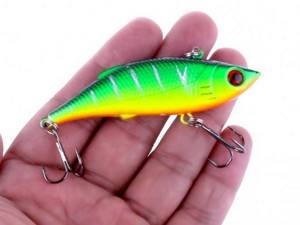
Ratlin color schemes can also be different. They come in two types:
- natural, silver;
- artificially bright, poisonous and acidic.
The first option is recommended for use in clear water, where, when fishing, the silver sides of the vibe reflect the sun's rays well. In muddy water or in the bottom depths, baits of brighter, “screaming” colors work better: orange, red, green, violet-blue. Such colors are capable of attracting the attention of potential prey from afar. Ideally, every fisherman should have rattlins of various shapes, colors and sizes in his arsenal in order to use them most effectively in different circumstances.
By buoyancy
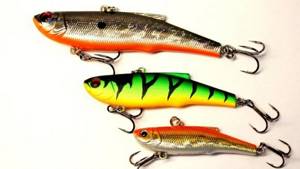
Most rattlins are made from dense polymers that have negative buoyancy. This allows for better play when fishing vertically: the bait is lifted up by the fisherman and then goes down on its own, imitating the movements of a small fish. Based on buoyancy, vibes are divided into three types:
- Heavy, sinking quickly. Used for deep places and bottom fishing.
- Medium, slowly sinking. They are able to stay in the water column longer, slowly descending when moving vertically.
- With neutral buoyancy. Such vib-suspenders appeared relatively recently, and are more suitable for summer fishing. Their peculiarity is good play when fishing horizontally, which is impossible to achieve when fishing from holes.
By attachment point
The attachment point of the vibes is located on the back and is carefully selected for the best behavior of the bait in the water. In different designs, the eyelet for attaching the fishing line can be shifted towards the head or towards the tail, which affects the movement of the bait when retrieving it. Some models are capable of not only vibrating the body as it sinks to the bottom, but even describing cyclic circles. By doing this, they imitate the behavior of a wounded fish, attracting additional attention from aquatic predators.
Some fishermen strive to improve factory rattlins with their own hands. To do this, they can replace tee hooks with double or single ones. To better attract fish, colored baits are put on the hooks, emphasizing the point of attack for the predator. But when upgrading vibes, you should take into account that by doing this you can shift the center of gravity. As a result, the bait will stop playing when retrieving as it should and will lose its effectiveness. Experienced fishermen advise testing the vib in the bathroom after updating it yourself to check whether its behavior has changed during the modernization.
Noise and non-noise baits
A design feature of rattlins is the presence of a rattle inside that makes noise when moving. The noise parameters vary: in some modifications the sound is quite loud, in others it is barely audible. Noise baits are intended for summer fishing in open water. They can also be successfully used on the first ice, when the fish are still quite active.
But in the dead of winter, loud noise can only scare away the fish. This is especially true for pike perch, which, unlike pike, is more careful and tries to avoid any suspicious sounds at this time. For ice fishing, you should take the quietest vibrations. Under the ice, even light sounds become clearly audible and are able to attract the attention of fish.
